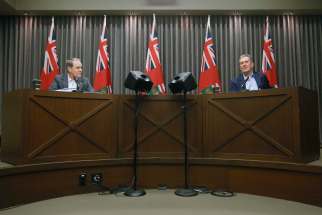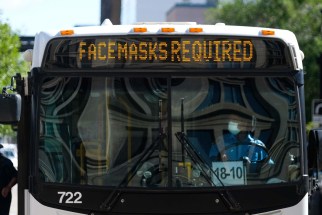Alarm bells ring as contact tracing clock ticks on
Read this article for free:
or
Already have an account? Log in here »
To continue reading, please subscribe:
Monthly Digital Subscription
$0 for the first 4 weeks*
- Enjoy unlimited reading on winnipegfreepress.com
- Read the E-Edition, our digital replica newspaper
- Access News Break, our award-winning app
- Play interactive puzzles
*No charge for 4 weeks then price increases to the regular rate of $19.00 plus GST every four weeks. Offer available to new and qualified returning subscribers only. Cancel any time.
Monthly Digital Subscription
$4.75/week*
- Enjoy unlimited reading on winnipegfreepress.com
- Read the E-Edition, our digital replica newspaper
- Access News Break, our award-winning app
- Play interactive puzzles
*Billed as $19 plus GST every four weeks. Cancel any time.
To continue reading, please subscribe:
Add Free Press access to your Brandon Sun subscription for only an additional
$1 for the first 4 weeks*
*Your next subscription payment will increase by $1.00 and you will be charged $16.99 plus GST for four weeks. After four weeks, your payment will increase to $23.99 plus GST every four weeks.
Read unlimited articles for free today:
or
Already have an account? Log in here »
Hey there, time traveller!
This article was published 29/10/2020 (1867 days ago), so information in it may no longer be current.
The provincial government says it doesn’t know how long it’s taking for public health officials to connect with people infected with COVID-19 or their close contacts.
With infection rates and the number of COVID-19 patients admitted to hospital growing at an alarming rate, the province’s inability (or refusal) to share contact tracing data with the public raises serious questions about how many people may be spreading the novel coronavirus unwittingly.
The Free Press has asked the provincial government repeatedly over the past week for pandemic contact tracing information, including how long it’s taking public health officials to follow up with people who test positive and to track down their close contacts.
“We do not have these statistics readily compiled, and do not have the capacity to pull them at this time,” a government spokeswoman said in an email Wednesday.
Manitoba Health Minister Cameron Friesen said contact tracing data is “very important.” When asked this week how far behind the province has fallen on contact tracing, Friesen said he didn’t have the details.
The recommended time to contact an infected person and close contacts after a positive test (usually by telephone) is 24 hours. Delays beyond that undermine efforts to break transmission chains of SARS-CoV-2, the virus that causes COVID-19. The longer the delay, the greater the chance close contacts are spreading the virus without knowing it.
The province says its target is to connect with 90 per cent of infected people and close contacts within 24 hours. It’s a benchmark public health officials said they were meeting earlier in the pandemic. Now, with hundreds of new cases and thousands more close contacts to track every week, it’s unknown what that percentage is.
There have been multiple media reports in recent weeks about people waiting days to be contacted by public health following a positive test.
Either the numbers are so bad government is refusing to share them or public health is so overwhelmed it doesn’t have time to compile reliable data. In either case, it could be a sign Manitoba has lost control over contact tracing (which happened earlier this month in Ottawa, Toronto and Montreal).
When asked Wednesday how far behind Manitoba is on contact tracing, Dr. Brent Roussin, the chief provincial public health officer, said he couldn’t quantify it because a backlog is making it difficult to keep track.
He did say on Oct. 19, the median time between a positive test and a contact tracing follow-up was 60 hours — well above the recommended time of 24 hours. There’s since been no update, even though the province has reported more than 1,000 new cases in the week-plus that followed.
In September, the median number of close contacts per case had doubled to four, from two in the summer.
Contact tracing is important to ensure those who may have been exposed to the virus self-isolate as soon as possible. It’s seen as a critical tool to interrupt transmission chains, especially where there are large clusters.
It also allows trained public health nurses to provide information directly to affected people, including answering case-specific questions. For some, arrangements need to be made for alternative accommodations when they can’t self-isolate at home.
However, the system has to be properly staffed and equipped with modern technology to work effectively, especially as cases rise.
It’s obvious the province didn’t adequately prepare for the recent surge; it’s now relying on external agencies such as the Red Cross and Statistics Canada to help with the workload. Questions remain about whether staff in those organizations have the expertise to provide people with the public health advice they may require.
Widespread testing, combined with timely contact tracing, is seen globally as one of the most effective ways to combat the spread of COVID-19.
With a backlog that could be too lengthy to overcome, Manitoba may have missed an important window of opportunity to stay ahead of the disease.
tom.brodbeck@freepress.mb.ca

Tom has been covering Manitoba politics since the early 1990s and joined the Winnipeg Free Press news team in 2019.
Our newsroom depends on a growing audience of readers to power our journalism. If you are not a paid reader, please consider becoming a subscriber.
Our newsroom depends on its audience of readers to power our journalism. Thank you for your support.







